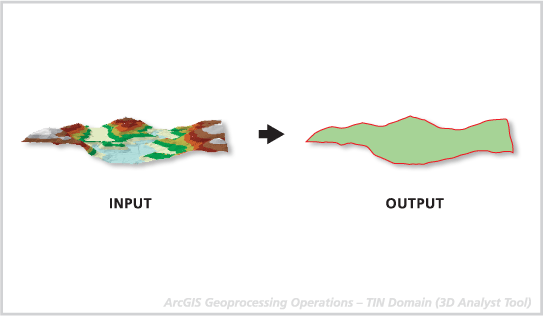| Label | Explanation | Data Type |
Input TIN | The TIN dataset that will be processed. | TIN Layer |
Output Feature Class | The feature class that will be produced. | Feature Class |
Output Feature Class Type | The geometry of the output feature class.
| String |
Summary
Creates a line or polygon feature class representing the interpolation zone of a triangulated irregular network (TIN) dataset.
Illustration

Usage
This tool can be used to generate a convex hull (the minimum bounding polygon) around a set of points. If there aren't any clip or erase polygons used to define the TIN, the domain is equivalent to the convex hull.
The output geometry is placed in one feature record and may be either a single or multipart geometry, depending on the nature of the interpolation zone. For example, if the interpolation zone is composed of islands or contains holes, the resulting geometry will be multipart.
Note:
3D polygons only contain elevation values along the perimeter of the features, as interior portions of the polygon will not contain any vertices. When drawn in 3D with an area fill, the boundary vertices are arbitrarily connected to triangles for rendering. Unless the polygon is planar, either sloped or horizontal, it's unlikely the fill will accurately represent the interior surface. For this reason, it is recommended that you draw nonplanar 3D polygons without fill symbology.
Parameters
arcpy.ddd.TinDomain(in_tin, out_feature_class, out_geometry_type)
| Name | Explanation | Data Type |
in_tin | The TIN dataset that will be processed. | TIN Layer |
out_feature_class | The feature class that will be produced. | Feature Class |
out_geometry_type | The geometry of the output feature class.
| String |
Code sample
The following sample demonstrates the use of this tool in the Python window:
arcpy.env.workspace = 'C:/data'
arcpy.ddd.TinDomain('tin', 'tin_domain.shp', out_geometry_type='POLYGON')The following sample demonstrates the use of this tool in a stand-alone Python script:
'''****************************************************************************
Name: Define Data Boundary of LAS File
Description: This script demonstrates how to delineate data boundaries of
LAS files with irregularly clustered points. It is intended for
use as a script tool with one input LAS file.
****************************************************************************'''
# Import system modules
import arcpy
# Set local variables
inLas = arcpy.GetParameterAsText(0) # input LAS file
ptSpacing = arcpy.GetParameterAsText(1) # LAS point spacing
classCode = arcpy.GetParameterAsText(2) # List of integers
returnValue = arcpy.GetParameterAsText(3) # List of strings
outTin = arcpy.GetParameterAsText(4) # TIN created to delineate data area
outBoundary = arcpy.GetParameterAsText(5) # Polygon boundary file
try:
# Execute LASToMultipoint
lasMP = arcpy.CreateUniqueName('lasMultipoint', 'in_memory')
arcpy.ddd.LASToMultipoint(inLas, LasMP, ptSpacing, class_code,
"ANY_RETURNS", "", sr, inFormat, zfactor)
# Execute CreateTin
arcpy.ddd.CreateTin(outTin, sr, "{0} Shape.Z masspoints"\
.format(lasMP), "Delaunay")
# Execute CopyTin
arcpy.ddd.CopyTin(outTin, "{0}_copy".format(outTin))
# Execute DelineateTinDataArea
maxEdge = ptSpacing * 4
arcpy.ddd.DelineateTinDataArea(outTin, maxEdge, "PERIMETER_ONLY")
# Execute TinDomain
arcpy.ddd.TinDomain(outTin, outBoundary, "POLYGON")
except arcpy.ExecuteError:
print(arcpy.GetMessages())
except Exception as err:
print(err)